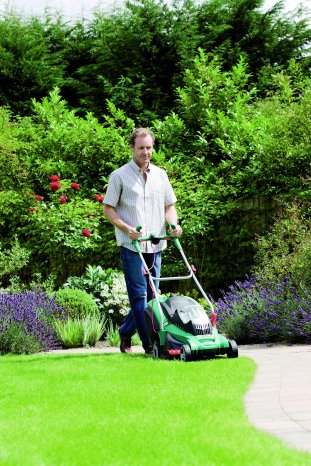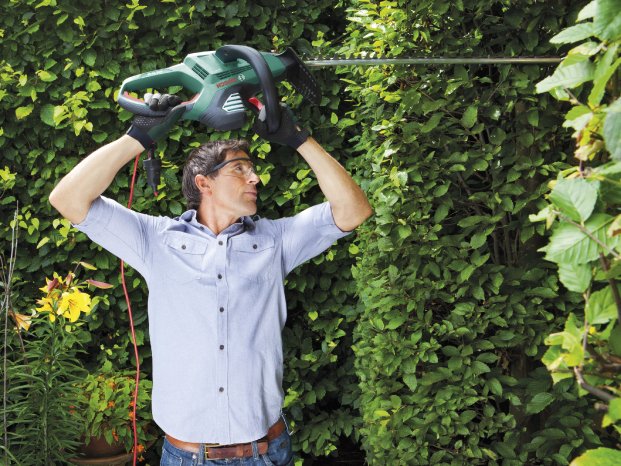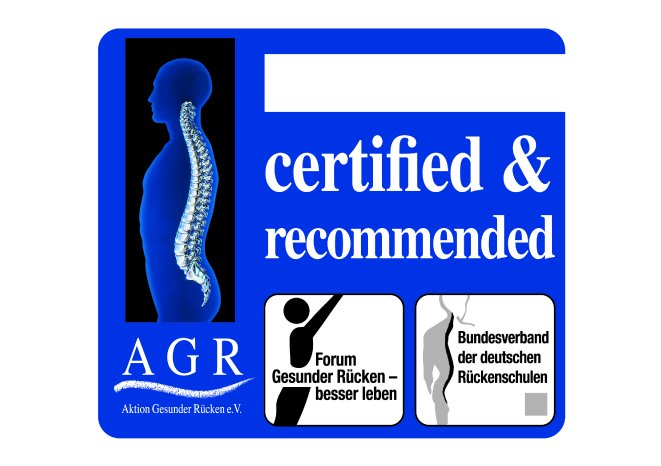Mowing the lawn: it's the posture that counts
The main focus of attention for hobby gardeners is usually the lawn. It is carefully tended and regularly mown. Depending on the size of the grassy area, lawn mowing offers intensive exercise. But lawn mowing can also have negative side effects. If the lawnmower is not ideally adjusted to the gardener's physical proportions, it can be difficult to manoeuvre; if the handles mean that the hands are held in a rigid, monotonous position, a day in the garden can come to a painful end. The results are tension and pain in the neck and back, together with aching joints. Manufacturers such as Bosch have meanwhile recognised the problems and developed ergonomic lawnmowers that can be adjusted individually and are uncomplicated to handle. The AGR knows what matters:
- To adjust the mower to different body sizes, it must be possible to adjust the length of the handles. Only an upright posture ensures that the lawn can be mown in comfort.
- The lawnmower handholds should also have an ergonomic design to keep the wrists straight. The possibility of holding the hands in different positions also relieves the strain on the muscles.
- The lawnmower weight also plays a crucial role in back compatibility. Frequently the lawnmower has to be brought up from the cellar or out of the garden shed and carried over large distances. It is therefore advisable to choose a lawnmower with the lowest possible weight - between 11 and 15 kilo - and one with special carrying handles to make it easier to transport. Handles that fold down also make it easier to stow the lawnmower away for next time.
- Being easy to operate is another crucial feature of ergonomic lawnmowers. All switches and levers must be easy to work. This applies to the central adjustment of the cutting height, the easily removable grass catcher and also to adjusting the lawnmower height.
- Optimum distribution of the weight across the axles also makes the lawnmower easy to steer.
The battery-driven and electric Rotak lawnmowers by Bosch fulfil the AGR test criteria and have therefore been awarded the seal of approval "certified & recommended." They warrant back-friendly posture and handling, and are simple to adapt and adjust, as well as being easy to manoeuvre.
Well-tended hedges without backache
Regular hedge trimming with unsuitable tools can also be torture for the back. Heavy hedgecutters that are difficult to operate and don't lie well in the hand can place a great strain on the back muscles and damage the spinal column. By contrast, the electric hedgecutters by Bosch (AHS 65-34 and AHS 70-34) permit back-friendly hedge trimming and have therefore been awarded the AGR seal of approval. Ergonomic hedgecutters have to fulfil the following criteria:
- To relieve the muscles, it must be possible to hold the hedgecutters in different positions. The switches must be easy to operate in every position.
- The spacing between the handles must permit natural handling. The handles should also be ergonomically shaped and made of non-slip materials, such as SoftGrip.
- The centre of gravity of the hedgecutters must ensure that they are horizontally balanced when held at the front handle.
- A transparent handguard offers an optimum field of vision while the body and head remain upright.
- Lightweight hedgecutters (max. 4 kg for a cutting thickness of more than 30 mm) with a high weight-to-power ratio (more than 180 watt/kg) make the tool easy to use.
- It is advisable for the power cable outlet to be located at the rear of the handle so that the cable does not interfere when working.
Raking, weeding, digging: here too, ergonomic design is crucial.
Ergonomic tools come up trumps also when weeding, digging or raking. The products made by gardening tool manufacturer Ergobase fulfil the main criteria in this respect for being awarded the AGR seal of approval, such as individually adjustable grasping heights, favourable load/power lever ratio and ergonomic handle designs. The Ergobase spade and the Gartenboy, a multifunctional implement for forking, raking and hoeing, protects the gardener's back and prevents incorrect strains. The Gartenboy acts as the extension of the gardener's hand and is used with gentle turning movements which make it ideal for weeding and also for loosening hard earth. The long handle prevents the need to bend over constantly and relieves the strain on the spinal column and on the joints. The S-shaped handle of the spade acts as a perfect lever in all movements and thus fosters back-friendly gardening. In addition, the S-shape reduces impact and shock movements.
In brief:
To ensure that the start of the gardening season does not end in backache, the Campaign for Healthier Backs AGR gives tips for back-friendly gardening. Ergonomic tools are indispensable for healthy gardening. Garden tools such as the Rotak lawnmower or hedgecutters by Bosch prevent incorrect posture and permit fatigue-free working. They have therefore been awarded the proven AGR seal of approval "certified & recommended."
More information about back-friendly daily routines and back-friendly everyday products marked with the AGR seal of approval is available on www.agr-ev.com




